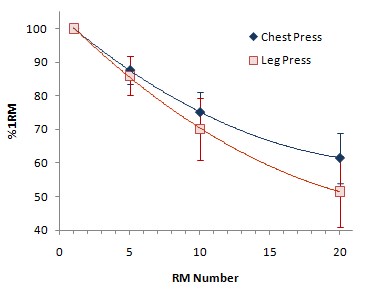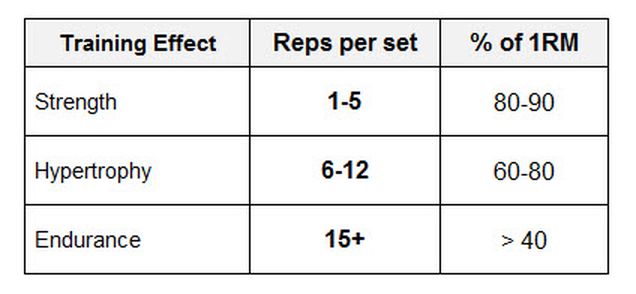Appropriate program design is key the key to successful resistance training1. There’s more that goes in to designing a session for a Strength Circuit or ABT class at MPF than you might realise.
Training prescription is linked to the understanding of physiological adaptations and how these can be elicited by specifically manipulating several different variables2:
- Muscle action used
- Load
- Volume (total number of set & reps)
- Exercises selected & workout structure (number of muscle groups trained)
- Sequence of exercise performance
- Rest intervals between sets
- Repetition velocity
- Training frequency
When we write your program, we’ll specify the training load through the number of repetitions to perform; this represents the number of times the weight can be lifted & lowered before the onset of fatigue. For example, a weight that can be lifted 8 times is described as an 8RM
As the number of prescribed repetitions increases, the absolute mass that can be lifted decreases. The below graph demonstrates this relationship for two key lifts. As we can see, a 4RM load is heavier than an 8RM load. 1RM therefore is the highest weight that can be lifted and is a common way to define an individual’s maximum muscle voluntary strength.

So how exactly do we go about targeting a specific adaptation, e.g. hypertrophy, strength, power, muscular endurance?
The Research
Several studies have shown that training with loads corresponding to 80–85% of 1 RM and beyond (e.g., 1–6 RM) were most effective for increasing maximal dynamic strength1. Loads lighter than this (12–15 RM and lighter) but are very effective for increasing absolute local muscular endurance1. Moderate-to-heavy loads, moderate-to high repetitions, and multiple sets per exercise are characteristic of hypertrophy training (although strength and local muscle endurance are also enhanced with these programs1.
Campos et al showed that physical performance and muscular and physiological adaptations are closely linked to the intensity and number of repetitions performed3. Young, male subjects trained leg press, squat, and knee extension 2-3x per week for 9 weeks following one of four regimens:
- High load/low rep: 4 sets of 3-5 reps approx. 90% 1RM
- Intermediate load/rep: 3 sets of 9-11RM approx. 70% 1RM
- Low load/high rep: 2 sets of 20-28RM approx. 45% 1RM
- Non-exercising control group
They found that the 1RM increased for all groups, but the strength gains were highest for the low rep group. In addition to the training, it was also thought that some learning effect may have taken place in this group since their program had exposed them to lifting very heavy loads. Muscular endurance improved across the board, but the greatest results were seen in the high rep group, who also were the only group to see improvements in their aerobic fitness. Muscle cross-sectional area (i.e. muscle size) increased for the low and intermediate rep groups by around 17% and 18% respectively.

Holm also showed that training 3x per week over 12 weeks with either a high (70% 1RM) or light (15.5% 1RM) load was sufficient to improve maximal strength an induce muscle hypertrophy4. However, as with the aforementioned study, the heavier load training was superior in producing adaptive changes in muscle size and strength.
In addition to the number of repetitions per set of each exercise, the number of sets also contributes to the overall volume and influences muscular adaptations. Breaking a session into three sets is considered superior to one-set training for inducing hypertrophy. In subjects who performed either one set or three sets of a range of upper and lower body exercises (leg press, leg extension, leg curl, seated chest press, seated rowing, lat pull-down, bicep curls, shoulder press), significant hypertrophy was observed under both conditions, but was significantly more for the three-set group5.
As an aside, to train specifically for muscular power we need to maximise the ability to use strength quickly. This can be achieved through heavy loads, low reps, and high sets, but most importantly at a very fast, yet controlled, movement velocity.
So how do we use this information?
In summary:

So when prescribed a specific number of repetitions in training, the easiest way to find the correct weight is to start off a little lighter for the first set, and then add more load for subsequent sets if you feel like you could have done more weight or more repetitions. Then, once you find a weight that you cannot do any more than the prescribed number of repetitions, then you’ve found the correct weight. As you get stronger, you should be able to start lifting a heavier weight to achieve the same relative load, or lift the same weight for more repetitions.